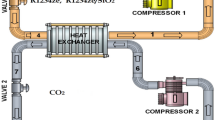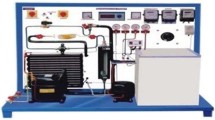Abstract
Every year, the world's energy consumption increases rapidly. One of the main causes of the rising pattern of energy consumption around the world is the increase in the number of refrigeration and air-conditioning systems in both the commercial and residential sectors. It is necessary to improve these systems' energy efficiency in light of environmental concerns and energy security. Investigating the R134a/TiO2 nanorefrigerant's heat transfer properties is the main objective of the current effort. In a horizontal smooth tube, flow boiling heat transfer investigations have been carried out at varied mass fluxes, heat fluxes, particle concentrations, and vapour quality. The findings demonstrate that adding TiO2 nanoparticles to the refrigerant significantly improves its heat transfer properties. It is discovered that the greatest increase enhancement factor is 101.3%. The performance of a vapour compression refrigeration system using nanorefrigerant was also investigated through experimental investigations, which produced the following findings. Using nanorefrigerants, the refrigeration system's performance coefficient is enhanced by 19.4%, and power consumption is decreased by 8.33%. The outcomes of the experiment point to the potential of using nanorefrigerants in the creation of energy-efficient refrigeration systems.
Access provided by Autonomous University of Puebla. Download conference paper PDF
Similar content being viewed by others
Keywords
1 Introduction
Nanofluids were first proposed as a revolutionary heat transfer medium by Choi et al. [1]. Nanofluids are created colloids of host fluids and nanoparticles. Researchers have recently considered using energy-efficient nanoparticles into lubricants and refrigerants. There are two categories of nanorefrigerants: direct refrigerants and lubricants-based refrigerants. Although in the latter, nanolubricants are combined with the refrigerants, the former directly disperses the required amount of small nanoparticles in the host refrigerant [2]. The thermophysical and heat transport capacities notably increase when nanoparticles are introduced to refrigerants, which increases efficiency and reliability [3, 4]. The scientific community on nanofluids has published very few experimental studies about the behaviour of boiling in nanorefrigerants [5]. Most research, many of which are also inconsistent [6], have demonstrated both advantages and disadvantages of flow boiling heat transfer [7]. The current study [8] employs an experimental methodology to investigate the effects of incorporating TiO2 nanoparticles into R134a refrigerant, with a focus on flow boiling regime studies.
2 Experimental Methodology
2.1 Flow Boiling Heat Transfer Studies on R134a/TiO2 Nanorefrigerant
To validate the experimental design, the estimated heat transfer coefficient for pure R134a from the literature is compared with the experimental value. Studies utilizing TiO2-nano refrigerant were the next to investigate the impact of nanoparticles on the heat transfer coefficient. It was decided to use particle concentrations of 0.1, 0.4, and 0.8 vol%. The effects of particle concentration, heat flow, mass flux, and vapour quality are investigated concerning the heat transfer coefficient (HTC).
2.1.1 Experimental Test Rig
ASTM D7863-17 standard is followed to conduct the convective heat transfer experiments [9]. Figure 1 shows the schematic diagram of the experimental set-up.
The test evaporator is a horizontal copper tube that is smooth, 10.2 mm in diameter, and 1 m long. The refrigerant is cycled through using a gear pump, which also makes up for pressure loss. To guarantee sub-cooled liquid at the pump's inlet, the temperature of the condensing medium is controlled concerning the saturation temperature of the refrigerant matching the pressure. It is anticipated that there will be no heat loss and that the heat input into the test portion will remain constant. T-type thermocouples are used at six different points along the test section to measure the outer tube wall temperature with an accuracy of 0.50 °C. The heat transfer coefficients acquired from various sources are compared using the correlation for R134a given by Panek et al.
2.2 Performance Evaluation of Vapour Compression Refrigeration System (VCRS)
Experimental research has been done to explain how nanorefrigerant affects VCRS performance. For the performance tests, an in-house test rig is created. In the refrigerant compressor, tests are carried out using R134a+ pure PAG (poly alkylene glycol) lubricant and R134a+ TiO2-PAG nanolubricants. The experimental study's assumed particle concentration is 0.1 vol%. To establish repeatability, the experiments are repeated in identical environmental settings, and it is discovered that the results roughly match. For the purpose of calculating the performance characteristics, average values are used.
3 Results and Discussion
3.1 Flow Boiling Heat Transfer of R134a/PAG Oil and R134a/TiO2/PAG Oil
The heat transfer coefficients at various mass fluxes and volume fractions are compared in Fig. 2. It is evident that the flow boiling heat transfer properties are significantly influenced by the nanorefrigerant. The graph unequivocally demonstrates that, for all mass fluxes, the presence of nanoparticles in the refrigerant resulted in a higher heat transfer coefficient than the mixture of pure lubricant and refrigerant. The outcomes also demonstrate that the mass flux is accompanied by an increase in the heat transfer coefficient. The reasons for the rise in HTC are a change in flow regimes and higher liquid velocities at higher mass fluxes. The maximum HTC for nanolubricants is 196.13, 211.28, and 205.28 W/m2 K, respectively, for concentrations of 0.1, 0.4, and 0.8 vol%. With a volume fraction of 0.4%, nanolubricant exhibits the highest.
3.2 Power Consumption and COP of the VCRS
With pure lubricant and nanolubricant, the hermetic refrigerant compressor's power consumption is assessed. The comparison of the power used by the refrigerant compressor and COP in both scenarios is shown in Fig. 3. By substituting nanolubricants for pure lubricant, the power used by the refrigerant compressor is decreased. TiO2 nanoparticles added to the lubricant have a notable impact on power usage. Compared with pure lubricant, there is an 8.33% decrease in power usage. The image makes it evident that adding nano-sized TiO2 particles to the refrigerant greatly increases the COP of the VCRS. In comparison with pure lubricant-refrigerant mixture nanorefrigerant, R134a-TiO2 exhibits a 19.4% increase in COP.
4 Conclusions
The current study examines the usage of nanorefrigerant in a VCRS from the perspective of energy conservation, as well as the experimental determination of the flow boiling heat transfer parameters of R134a/TiO2. The main conclusions are that (i) the flow boiling heat transfer properties of R134a-TiO2 nanolubricant outperform those of pure refrigerant at all particle concentrations, and (ii) at a volume fraction of 0.4%, the greatest flow boiling heat transfer coefficient is observed. Also, the performance coefficient of the vapour compression refrigeration system is raised by 19.4%, while the power consumption of the hermetic reciprocating compressor is reduced by 8.33%. The use of a revolutionary nanolubricant could result in the creation of HVAC systems that use less energy.
References
Eastman JA, Choi SUS, Li S, Thompson LJ, Lee S (1997) Enhanced thermal conductivity through the development of nanofluids. In: MRS proceedings, vol 457, pp 3–11
Nair V, Tailor PR, Parekh AD (2016) Nanorefrigerants: a comprehensive review on its past, present and future. Int J Refrig 67:290–307
Subramani N, Prakash MJ (2011) Experimental studies on a vapour compression system using nanorefrigerants. Int J Eng Sci Technol 3:95–102
Sharif MZ, Azmi WH, Redhwan AAM, Mamat R, Yusof TM (2017) Performance analysis of SiO2/PAG nanolubricant in automotive air conditioning system. Int J Refrig 75:204–216
Liu DW, Yang CY (2007) Effect of nano-particles on pool boiling heat transfer of refrigerant 141b. In: ICNMM, pp 789–793
Park KJ, Jung D (2007) Enhancement of nucleate boiling heat transfer using carbon nanotubes. Int J Heat Mass Transf 50:4499–4502
Peng H, Ding G, Jiang W, Hu H, Gao Y (2009) Heat transfer characteristics of refrigerant-based nanofluid flow boiling inside a horizontal smooth tube. Int J Refrig 32:1259–1270
Panek JS, Chato JC, Jabardo JMS, De Souza AL, Wattelet JP (1992) Evaporation heat transfer and pressure drop in ozone-safe refrigerants and refrigerant-oil mixtures
ASTM D7863-17 (2017) ASTM International, West Conshohocken, PA. www.astm.org
Author information
Authors and Affiliations
Corresponding author
Editor information
Editors and Affiliations
Rights and permissions
Copyright information
© 2023 The Author(s), under exclusive license to Springer Nature Singapore Pte Ltd.
About this paper
Cite this paper
Sanukrishna, S.S., Reshmi Krishnan, S. (2023). Energy Conservation in the Vapour Compression Refrigeration System Using Nanorefrigerant. In: Khan, Z.H., Jackson, M., Salah, N.A. (eds) Recent Advances in Nanotechnology. ICNOC 2022. Springer Proceedings in Materials, vol 28. Springer, Singapore. https://doi.org/10.1007/978-981-99-4685-3_8
Download citation
DOI: https://doi.org/10.1007/978-981-99-4685-3_8
Published:
Publisher Name: Springer, Singapore
Print ISBN: 978-981-99-4684-6
Online ISBN: 978-981-99-4685-3
eBook Packages: Chemistry and Materials ScienceChemistry and Material Science (R0)







